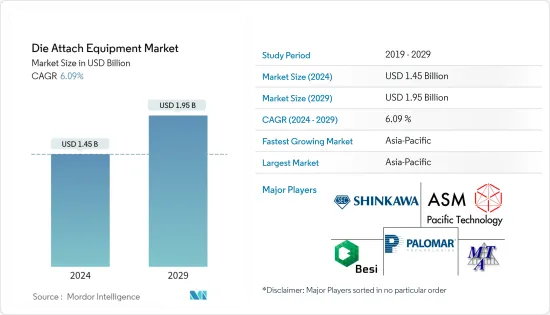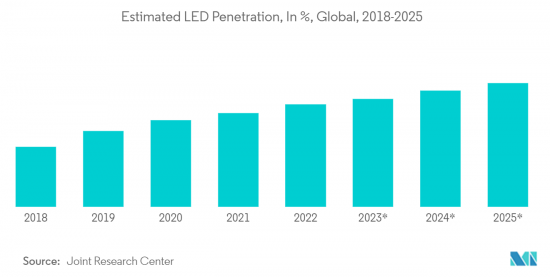PUBLISHER: Mordor Intelligence | PRODUCT CODE: 1406120

PUBLISHER: Mordor Intelligence | PRODUCT CODE: 1406120
Die Attach Equipment - Market Share Analysis, Industry Trends & Statistics, Growth Forecasts 2024 - 2029

The Die Attach Equipment Market size is estimated at USD 1.45 billion in 2024, and is expected to reach USD 1.95 billion by 2029, growing at a CAGR of 6.09% during the forecast period (2024-2029).
Growth is fueled by the increased use of stacked die technology in the Internet of Things (IoT) devices. In recent trends, the demand for hybrid circuits has remained strong due to emerging and existing applications in medical, military, photonics, wireless electronics, etc.
Key Highlights
- C2W hybrid bonding is a promising emerging technology that can enable direct Cu- Cu bonding and replace TCB for 3D stacked memory and high-end logic applications. However, C2W hybrid bonding is still in its early stages level. It is expected to hit the market in 2022/23 for logic devices with 2.5D structures, significantly assisting the equipment market's growth.
- The demand for the AuSn Eutectic Die-Attach technique drives the market. Traditionally, various die-attach products, which include metal-filled conductive epoxies, high lead-containing solders, and gold-silicon solders, were sufficient to mount the chip and have it perform reliably for the life of the device. However, the trend towards increasing heat generation, demand for compact devices, enactment of RoHS and REACH legislation, and the transition to GaAs chips limited the use of conventional materials. The demand for high device reliability has led engineers to evaluate various new materials for their die attachment.
- The suggested solder preforms are eutectic gold-tin and can be implemented for high volume or lab quantity adoption using a Palomar Technologies' die bonder. This equipment can handle the complete die-attach process, including high-accuracy pick-and-place of substrates, eutectic gold-tin preforms, and components; eutectic die-attach; and pulsed-heat reflow using a computer-controlled Pulse Heat Stage (PHS).
- The demand for discrete power devices drives the market. Copper clips are becoming increasingly popular as an alternative to traditional wire and ribbon bonding. Die-attach functionality is a feature of packaging solutions for discrete power components. The adoption of wide-bandgap semiconductor die technologies (SiC and GaN) brings new innovative packaging solutions, including silver sintering die-attach (materials include epoxy molding compounds and interconnection materials). The progressive transition from discrete SiC towards SiC modules in EV/HEV applications, the embedded-die packaged systems, and the integration of GaN devices in multichip systems are just a few examples of such a trend. This factor enhances the demand for the die attaches equipment for the discrete power devices.
- However, primarily dimensional changes during processing and service life and mechanical unbalance of moving parts during processing through equipment challenges the equipment's functionality which could restrain the market.
- Further, the impact of COVID-19 does not highly affect the demand for equipment. For instance, during the pandemic, Palomar Technologies announced that they got a request for manufacturing critical semiconductor components to address COVID-19. They saw an acceleration of orders of their 3880 Die Bonder equipment to assist in wireless communications and networking bandwidth, remote medicine, IoT in robotics, and video conferencing. This acceleration is similar for other market players. Hence, the demand for equipment has remained relatively high during the pandemic. This demand will continue to grow post-pandemic owing to the need for IoT devices, automation, and smart technologies.
Die Attach Equipment Market Trends
LED to Witness Significant Growth
- Die attach material is key in the performance and reliability of mid, high, and super-high power LEDs. The demand for die-attach equipment is increasing with an increasing LED penetration rate. The selection of suitable die-attach material for a particular chip structure and application depends on various considerations, which include the packaging process (throughput and yield), performance (thermal dissipation output and light output), reliability (lumen maintenance), and cost. Eutectic gold-tin, silver-filled epoxies, solder, silicones, and sintered materials have all been used for LED die attach.
- For instance, SFE provides an Epoxy Adhesive bonding method where its LED Epoxy Die Bonder machine features an index time of 0.2 Sec /Cycle (90 Percent Rate of Operation) with a chip size of 250 * 250 standards, providing lead frame recognition through 2 Cameras. Its software function provides auto mount level & pick-up level teaching functions.
- Further, conductive adhesives (mostly silver-filled epoxies) constitute LEDs' most extensive thermal die-attach materials (by unit number). They are compatible with existing back-end packaging equipment and provide an attractive cost/performance balance (typically up to 50 W/mK thermals with secondary reflow compatibility). As they stick to bare silicon, they are the most preferred material for dies without back-end metallization like GaN on silicon.
- Further, in the LED market, there are a lot of rivals or competitors, and ASM is one of the prominent players in this market, and its LED Epoxy High speed die bonder AD830 dominates in the LED market. As more and more countries are getting close to phasing out conventional bulbs, LEDs are continuing their march to the top of the market. According to Joint Research Center, The penetration rate of LEDs based on sales is raising and is expected to reach a penetration rate of 75.8 % by 2025. This factor enhances the demand for the die attaches equipment market.
- Furthermore, in September 2022, Palomar Technologies launched a new 3880-II die-bonder, which won the 2022 military+Aerospace electronics Innovation Award. This new machine includes options to maximize productivity, reduce programming time by up to 95% and improve overall bonder productivity.

Asia-Pacific Accounts for Significant Market Growth
- Asia-Pacific accounted for the significant growth of the die-attach equipment industry. More than 60% of OSAT (Outsourced Semiconductor Assembly And Test) players present across the world have their headquarters in the APAC region. These OSAT companies use die-attach equipment in the semiconductor fabrication process. Additionally, an increasing number of IDMs (Integrated Device Manufacturers) in the region is expected to boost the market growth shortly.
- In China and Taiwan, the mass production of electronic products, including smartphones, wearables, and white goods, uses several devices, such as optoelectronics, MEMS, and MOEMS. All these devices require die-attach equipment in the assembly process of these components.
- Further, South Korea, China, and mostly Japan's old age population are anticipated to accelerate the need for healthcare services during the forecast period, thus providing scope for devices, such as ventilators, dialysis, and blood pressure monitoring devices constituting MEMS pressure sensors. ESCAP estimates that the geriatric population in the region, aged 60 years and older, could penetrate at the rate of 10.64 by 2025 with 9.55 in the current year and raise to 18.44 by 2050, which represent 60 percent of the worlds population. The instance caters to the growth of the market due to the demand for die-attach equipment for MEMS pressure sensor.
- Furthermore, India is also witnessing growth in a number of smart cities, due to government initiatives and are expected to incorporate electronic solutions for purposes, such as surveillance, maintenance, monitoring, etc. According to smartcities.gov.in, the central government has allotted USD 977 million into the development of 60 such smart cities. This leads to the demand for a higher number of CMOS image sensors, which further supports the market growth.
- High Power lasers are finding extensive demand in industrial sectors for a wide range of applications, including cutting, welding, and fabrication. Companies are moving towards Laser technologies to take advantage of high performance and reliability. The advancement in laser diode significantly increases the demand for equipment, which processes the technique of Epoxy and Eutectic bonding.
- Further memory demand is expected to increase with the development of IoT, AI, and ADAS. As a result, productivity improvement in memory chip manufacturing and improvement of post-processing device reliability will be required more than in the past. To address this, in August 2022, Stanford engineers created a more efficient and flexible AI chip, which could bring the power of AI into tiny edge devices that contributes to improved throughput and reliability in memory production.
Die Attach Equipment Industry Overview
The die-attach equipment market is fragmented as the presence of local and global players penetrates the intense rivalry in the market. Further, players are focusing on improving their equipment performance in terms of throughput and yield through development and partnership, making the market more competitive. Key players are Be Semiconductor Industries N.V., ASM Pacific Technology Limited, Palomar Technologies Inc, etc. Recent developments in the market are -
- In October 2022, Hermetic Solutions Group (HSG) acquired the Intellectual property of DiaCool, from RHP Technologies. This expands HSG's product lineup and offers customers significantly more options for many years. HSG's DiaCool diamond composite material for heat sinks, die tabs, and heat spreaders provide customers with significant advantages over conventional laminate or MMC materials.
- In October 2022, Kulicke and Soffa received multiple new purchase orders for its thermo-compression solution and successfully shipped its first Fluxless Thermo-Compression Bonder (TCB) to a key customer and continues its position in the advanced LED Assembly.
Additional Benefits:
- The market estimate (ME) sheet in Excel format
- 3 months of analyst support
TABLE OF CONTENTS
1 INTRODUCTION
- 1.1 Study Assumptions and Market Definition
- 1.2 Scope of the Study
2 RESEARCH METHODOLOGY
3 EXECUTIVE SUMMARY
4 MARKET DYNAMICS
- 4.1 Market Overview
- 4.2 Market Drivers
- 4.2.1 Growing Demand of AuSn Eutectic Die-Attach Technology
- 4.2.2 Demand of Discrete Power Devices
- 4.2.3 LED Segment to Witness Significant Growth
- 4.3 Market Restraints
- 4.3.1 Dimensional Changes During Processing and Service Life and Mechanical Unbalance
- 4.4 Industry Value Chain Analysis
- 4.5 Industry Attractiveness - Porter's Five Forces Analysis
- 4.5.1 Threat of New Entrants
- 4.5.2 Bargaining Power of Buyers/Consumers
- 4.5.3 Bargaining Power of Suppliers
- 4.5.4 Threat of Substitute Products
- 4.5.5 Intensity of Competitive Rivalry
- 4.6 Assessment of Impact of COVID-19 on the Market
5 MARKET SEGMENTATION
- 5.1 Type
- 5.1.1 Die Bonder
- 5.1.2 Flip Chip Bonder
- 5.2 Bonding Technique
- 5.2.1 Epoxy
- 5.2.2 Eutectic
- 5.2.3 Soft Solder
- 5.2.4 Hybrid Bonding
- 5.2.5 Other Bonding Techniques
- 5.3 Application
- 5.3.1 Memory
- 5.3.2 RF & MEMS
- 5.3.3 LED
- 5.3.4 CMOS Image Sensor
- 5.3.5 Logic
- 5.3.6 Optoelectronics / Photonics
- 5.3.7 Other Applications
- 5.4 Geography
- 5.4.1 North America
- 5.4.2 Europe
- 5.4.3 Asia Pacific
- 5.4.4 Latin America
- 5.4.5 Middle East and Africa
6 COMPETITIVE LANDSCAPE
- 6.1 Company Profiles
- 6.1.1 Palomar Technologies, Inc.
- 6.1.2 Shinkawa Ltd.
- 6.1.3 MicroAssembly Technologies, Ltd.
- 6.1.4 ASM Pacific Technology Limited
- 6.1.5 Be Semiconductor Industries N.V.
- 6.1.6 Kulicke and Soffa Industries, Inc.
- 6.1.7 Dr. Tresky AG
- 6.1.8 Fasford Technology Co Ltd.
- 6.1.9 Inseto UK Limited
- 6.1.10 Anza Technology Inc.
7 INVESTMENT ANALYSIS
8 MARKET OPPORTUNITIES AND FUTURE TRENDS




